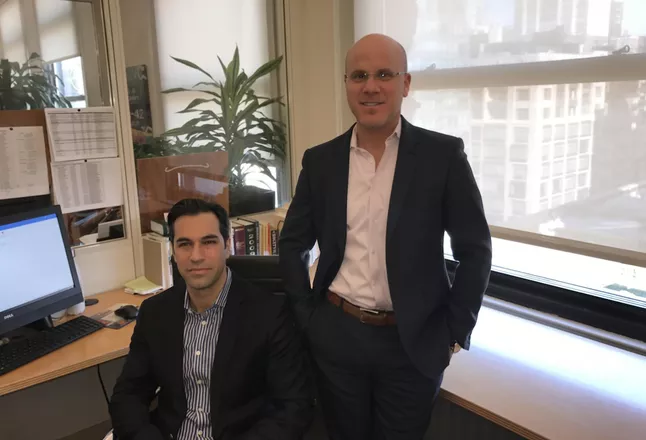
February 21st, 2017, by Alec Berkman
New York City’s CRE pros still have a lot to look forward to in 2017, according to The Besen Group chief sales officer Ron Cohen (seated above with executive managing director Greg Corbin). Here are their top 5 reasons for being cautiously bullish on investment sales in 2017.
1. Robust Market
“While sales were down last year, they were hardly out,” Cohen said. “At almost $49B, they represented the fourth best year on record, and prices citywide, $530/SF on average, were at an all-time high, 9% higher than last year’s.”
The second half of 2016 had less dollar volume than the first, and investment sales were down almost 25% from 2015’s $77B, which was viewed negatively by many, but could indicate a large amount of dormant capital waiting to be deployed.
In Manhattan, dollar volume dropped by 34% and the number of properties sold fell 30%, but the outer boroughs performed significantly better. Taken together, they demonstrated a 6% increase from 2015.
This reflects neighborhoods undergoing revitalization, gentrification and growth and generates new and safer investment opportunities. Manhattan’s already limited stock, and the high prices its properties command, do not seem to be going anywhere.
2. Tax Legislation
If President Donald Trump’s administration decides to slash the corporate tax rate, this action will reverberate throughout the industry, stimulating market activity. Corporations are subject to a top federal income tax of 35% (effectively 27% for U.S. firms), including long-term capital gains. Trump has said he wants to reduce that to 15%.
“Since many foreign investors invest through a domestic corporate blocker entity, they are at an approximate 11% disadvantage when compared to most domestic non-corporate investors, who get a preferential capital gains rate of 23.8%,” said Berdon LLP’s Dan Shapiro.
Investment expenditure, particularly foreign, would increase globally with this change (provided compensatory barriers and regulations aren’t established). This would fuel investment sales and strengthen capital flows, particularly Asian and Middle Eastern.
3. Strong Economic Fundamentals
In NYC, the unemployment rate, hovering around 6%, is about half of what it was in 2010-2012. The vacancy rate also remains quite low at 2.1%. These two metrics indicate a thriving city economy and strong demand.
In January, the Consumer Sentiment Survey, a measure of how optimistic Americans are about the economy, hit 98.5%, the highest figure since 2004. Although the New York Fed concludes this is exaggerated by partisanship, the propensity to spend is likely at least at pre-election levels, which were still relatively high.
4. Affordable Financing
Despite recent news about the Fed’s incremental interest rate bumps, experts believe the overall increase in 2017 to be capped at around a quarter of a percent. The reason for the sensationalized coverage is that rising rates signal confidence in the economy. A 0.25% change is unlikely to significantly affect lending activity.
Capital remains quite cheap and accessible nationwide. A report published by the Mortgage Bankers Association found over $500B in commercial real estate loans were originated in 2016.
Although capital stacks are increasingly intricate and may encompass a larger number of participants, finding and engaging equity partners and lenders — who themselves compete for prime projects — may be easier in 2017. Many industry experts believe a lot of capital is waiting on the sidelines.
5. 421-a
“We are obviously hopeful to see 421-a revived,” Corbin said. “Interest in development sites has decreased dramatically, and although we don’t expect construction financing to become readily available like it was in the past, the abatement will stimulate activity in land sales.”
In January, Gov. Andrew Cuomo rechristened the program — which costs the city over $1B in property tax revenue — Affordable New York. It will create 2,500 units of affordable housing per year.
Developers, the primary beneficiaries of the program, and labor unions largely approve of the legislation. Cuomo held the bill hostage until lobbying groups for developers and construction workers found common ground, compromising on wage floors. NYU’s Furman Center published a report concluding the new 421-a should be enough to offset the burden to developers imposed by the wage floor — $60/hour in Manhattan below 96th Street and $45 in the Brooklyn and Queens waterfront for buildings larger than 300 units — if construction costs don’t rise more than 18% in Manhattan.
To learn more about this Bisnow content sponsor, click here.
Contact Alec Berkman at alec.berkman@bisnow.com








